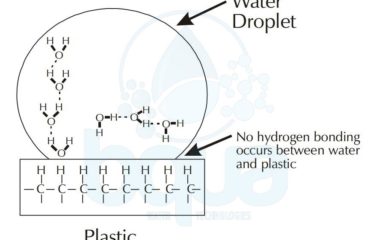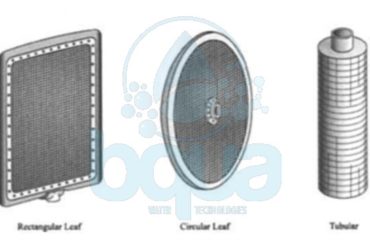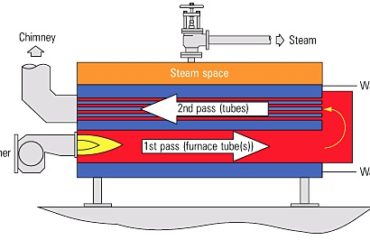What is Dissolved Air Flotation Definition – DAF Unit
Dissolved air flotation (DAF) technology is very suitable for removal of floating particulate foulants such as algal cells, oil, grease or other contaminants that cannot be effectively removed by sedimentation or filtration. Dissolved Air Flotation DAF system can typically produce effluent turbidity of <0.5 NTU and can be combined in one structure with dual-media gravity filters for sequential pretreatment of seawater. Dissolved Air Flotation (DAF) process uses very small air bubbles to float light particles and organic substances (oil, grease) contained in the seawater. The floated solids are collected at the top of the DAF tank and skimmed off for disposal, while the low turbidity seawater is collected near the bottom of the tank. The time (and therefore, the size of flocculation tank) needed for the light fine particulates contained in the seawater to form large flocs is usually 2 to 3 times shorter than that in conventional flocculation tanks, because the flocculation process is accelerated by the air bubbles released in the flocculation chamber of the DAF tanks. In addition, the surface loading rate for removal of light particulates and floatable substances by DAF is approximately 10 times lower than that needed for conventional sedimentation. Another benefit of DAF as compared to conventional sedimentation is the higher density of the formed residuals (sludge). While residuals collected at the bottom of sedimentation basins typically have concentration of only 0.3 to 0.5 % solids, DAF residuals (which are skimmed off the surface of the DAF tank) contain solids concentration of 1 to 3 %. In some full-scale applications, the DAF process is combined with granular media filters to provide a compact and robust pretreatment of seawater with high algal and/or oil and grease content. Although this combined DAF/filter configuration is very compact and cost-competitive, it has three key disadvantages:
(1) complicates the design and operation of the pretreatment filters;
(2) DAF system loading is controlled by the filter loading rate and therefore, DAF tanks are typically oversized;
(3) Flocculation tanks must be coupled with individual filter cells. The feasibility of Dissolved Air Flotation DAF unit use for seawater pretreatment is determined by seawater quality and governed by source water turbidity and overall lifecycle pretreatment costs.
In flotation, the effects of gravity settling are offset by the buoyant forces of small air bubbles. These air bubbles are introduced to the flocculated water, where they attach to floc particles and then float to the surface. Flotation is typically sized at loading rates up to 10 times that for conventional treatment. Higher rates may be possible on high-quality warm water. Dissolved air flotation (DAF) is an effective alternative to sedimentation or other clarification processes. Modern DAF technology was first patented in 1924 by Peterson and Sveen for fiber separation in the pulp and paper industry (Kollajtis, 1991). The process was first used for drinking water treatment in Sweden in 1960 and has been widely used in Scandinavia and the United Kingdom for more than 30 years. Previous uses of the process in the United States have been to thicken waste-activated sludge in biological wastewater treatment, for fiber separation in the pulp and paper industry, and for mineral separation in the mining industry. Only recently has this process gained interest for drinking water treatment in North America. It is especially applicable when treating for algae, color, and low-turbidity water. The first use in the United States was at New Castle, New York, in a 7.5 mgd (28 ML per day) plant that began operation in 1993. A typical DAF unit is shown below:
Typical Dissolved Air Flotation DAF Unit / System
The DAF unit can handle source seawater with turbidity of up to 50 NTU. Therefore, if the source seawater is impacted by high turbidity spikes or heavy solids (usually related to seasonal river discharges or surface runoff), then DAF system may not be a suitable pretreatment option. In most algal bloom events however, seawater turbidity almost never exceeds 30 to 50 NTU, so the DAF technology can handle practically any red tide event. Although a DAF system have much smaller footprint than the conventional flocculation and sedimentation facilities, it includes a number of additional equipment associated with air saturation and diffusion, and with recirculation of portion of the treated flow, and therefore, their construction costs are typically comparable to these of conventional sedimentation basins. Usually, the O&M costs of DAF system is higher than these of gravity sedimentation tanks due to the higher power use for the flocculation chamber mixers, air saturators, recycling pumps, and sludge skimmers. The total power use for a Dissolved Air Flotation – DAF system is usually 2.5 to 3.0 kWh/1 0,000 m3/day of treated source seawater, which is Significantly higher than that for sedimentation systems (0.5 to 0.7 kWh/1 0000 m3/day of treated seawater).
Theory and Operation of a Dissolved Air Flotation DAF Unit
Effective gravity settling of particles requires that they be destabilized, coagulated, and flocculated by using metal salts, polymers, or both. The same is true for DAF. In gravity settling the flocculation process must be designed to create large, heavy floc that settles to the bottom of the basin. In Dissolved Air Flotation DAF unit, flocculation is designed to create a large number of smaller floc particles that can be floated to the surface. For efficient flotation, flocculated particles must be in contact with a large number of air bubbles.
Three mechanisms are at work in this air/floc attachment process:
• Adhesion of air bubbles on the floc surface
• Entrapment of bubbles under the floc
• Absorption of bubbles into the floc structure
The size of air bubbles is important. If bubbles are too large, the resulting rapid rise rate will exceed the laminar flow requirements, causing poor performance. If bubbles are too small, a low rise rate will result and tank size may need to be increased. In a typical Dissolved Air Flotation tank, flocculated water is introduced uniformly across the end of the tank, near the bottom, into the recycle dispersion zone. Recycle is continuously introduced through a distribution system of proprietary nozzles, valves, or orifices. When the recycle flow pressure is suddenly decreased from its operating pressure of 60 to 90 psi (414 to 620 kPa) to atmospheric pressure, saturated air within the recycle stream is released in the form of microbubbles with a size range of 10 to 100/xm, and averaging around 40 to 50/xm. These microbubbles attach to flocculated material by the mechanisms described previously, causing flocculated material to float to the surface. At the surface, the bubble-floc forms a stable and continuously thickening layer of float, or sludge. If left at the surface, the float can thicken to as much as 3% to 6% dry solids. This can be an advantage if solids are to be mechanically dewatered, because solids may be suitable for dewatering without further thickening, or the thickening process can be reduced. Sludge thickness depends on the time it is allowed to remain on the surface and the type of removal system employed.
Dissolved Air Flotation – DAF System – Key Design Criteria
Dissolved Air Flotation DAF system include three key components: flocculation chamber; flotation tank and recycling system. The design criteria for these three components are presented below:
| Flocculation System: | |
| Minimum Number of Tanks | 4 |
| Velocity Gradient | 30 to 120 s^-1 |
| Contact Time | 10 to 20 min |
| Flocculation Chambers in Series | 2 to 4 |
| Water Depth | 3.5 to 4.5 m |
| Type of Mixer | Vertical-shaft with hydrofoil blades |
| Blade Area/Tank Area | 0.1 to 0.2 % |
| Shaft Speed | 40 to 60 rpm |
| Flotation Chamber: | |
| Minimum Number of Tanks | 4 (same as filter cells if combined with filters) |
| Tank Width | 3 to 10 m |
| Tank Length | 8 to 12 m |
| Tank Depth | 2.5 t0 3m |
| Surface Loading Rate | 10 to 40 m3/m3/h |
| Hydraulic Detention Time | 10 to 15 min |
| Treated Water Recycle System: | |
| Recycling rate | 6 to 10 % of intake flow |
| Maximum Air Loading | 10 g/m3 |
| Saturator Loading Rate | 60 to 65 m3/m2/h |
| Operating Pressure | 4.0 to 6.5 bars |
Dissolved Air Flotation DAF process with built-in filtration (DAFF) is used at the 136,000 m3/day Tuas seawater desalination plant in Singapore (Kiang et aI., 2007). This pretreatment technology has been selected for this project to address the source water quality challenges associated with the location of the desalination plant’s open intake in a large industrial port (i.e., oil spills) and the frequent occurrence of red tides in the area of the intake. The source seawater has total suspended solids concentration that can reach up to 60 mg/L at times and oil and grease levels in the seawater could be up to 10 mg/L. The facility uses 20 build-in filter DAF unit, two of which are operated as standby. Plastic covers shield the surface of the tanks to prevent impact of rain and wind on DAF operation as well as to control algal growth. Each Dissolved Air Flotation DAF unit is equipped with two mechanical flocculation tanks located within the same DAF vessel. Up to 12 % of the filtered water is saturated with air and recirculated to the feed of the DAF unit.
BQUA Dissolved Air Flotation System – DAF unit
A combination of DAF followed by two-stage dual-media pressure filtration has been successfully used at the 45,400 m3/day El Coloso seawater reverse osmosis SWRO plant is Chile, which at present is the largest desalination plant in South America. The plant is located in the City of Antogofasta, where seawater is exposed to year-round red-tide events, which have the capacity to create frequent particulate fouling and biofouling of the SWRO membranes (Petry et aI., 2007). The DAF system at this plant is combined in one facility with a coagulation and flocculation chamber. The average and maximum flow rising velocities of the DAF system are 22 and 33 m3/m 2/h, respectively. This Dissolved Air Flotation DAF system can be bypassed during normal operations and is typically used during red-tide events . The downstream pressure filters are designed for surface loading rate of 25 m3/m’/h. Ferric chloride at a dosage of 10 mg/L is added ahead of the DAF system for source water coagulation. The DAF system reduces source seawater turbidity to between 0.5 and 1.5 NTU and removes approximately 30 to 40 % of the source seawater organics.
BQUA is a proud manufacturer of Dissovled Air Flotation Systems – DAF Units. Please feel free to contact us anytime with your inquiry and our team of specialists will be ready and glad to help you.




